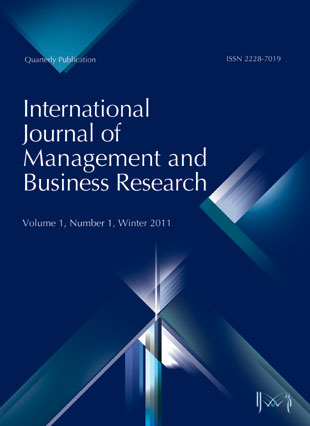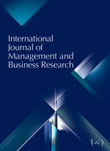فهرست مطالب

International Journal of Management and Business Research
Volume:1 Issue: 1, 2011
- تاریخ انتشار: 1390/04/29
- تعداد عناوین: 6
-
Page 1This research aimed at identifying the role of emotional intelligence (EI) -based management in improving faculty effectiveness. Research methodology was descriptive-survey of exploratory type. Statistical population were the faculty members in the Islamic Azad University branches across Tehran (N = 3500). The subjects of the study (sample) consisted of 351 faculty members selected through stratified random method. Data were collected via two researcher-administrated questionnaires. Statistical operations employed for data analysis included: Independent T-test, Wilkoxon Test, Variance Analysis and Factor Analysis. Findings showed that there are 10 EI-based leadership factors which determine faculty effectiveness. Results also suggested a significant difference between desirable and current situations in Islamic Azad universities.
-
Page 9Customer orientation is one of the new approaches which is recently considered by the Iranian Healthcare Centers. The present study aims to identify the main factors of customer orientation in Iranian hospitals. The study is done through analysis of a questionnaire designed after recognition of the main variables. Iranian Social Security Organization Hospitals (the major governmental health institutions in Iran) were chosen as a sample among all Iranian healthcare centers (n=48). Content validity and construct validity were assured with expert judgment and the reliability of the questionnaire was determined using Cronbach’s alpha and Pearson correlation (1st and 2nd times). Cronbach’s alpha coefficient was respectively as 0.826 and Pearson correlation was (p<0.001) 0.975. The questionnaire was filled out by the research community. After collection of sufficient samples, the exploratory and confirmatory factors were analyzed. The findings of the study showed two factors after factor analysis; namely, “consideration about customer” and “consideration about stakeholder”. The calculated fitness indexes proved the desirability and appropriateness of the factors and their structural relations. It is concluded that these factors have substantial roles in the implementation of customer orientation approach in these organizations.
-
Page 15This current study aimed at investigating the effects of gender (male versus female) and age (younger versus older) on consumer ethnocentrism and animosity in Indonesia in regard to eight opposed countries. Based on the ANOVA test, the findings showed that female and young consumers have a higher political and economical animosity; while female and old consumers tend to have higher ethnocentrism. The Indonesian consumers are very ethnocentric; The United States of America and Malaysia found to be the two opposed countries with the highest score of animosity. The economic animosity is higher than politic animosity in China and Taiwan as the opposed countries. These findings can be utilized by marketers in designing marketing communication and segmentation.
-
Page 19The study aimed at a critical assessment of the environmentalism components introduced in the civil engineering curriculum in India polytechnic colleges (state of Tamilnadu) and associate degree level Technical Institutions in Iran. The objective of study was to compare technical education curriculum in civil engineering with respect to environmentalism. Both qualitative and quantitative techniques were used as content analysis method. Qualitative analysis was carried out to compare the curriculum with respect to environmentalism components. Study samples are drawn from the educational and academic institutions in India and Iran. For the purpose of quantitative analysis, t-test, F-test, and factor analysis were used. To establish reliability of the tools, Cronbach Coefficient of Alpha was calculated. Then quantitative analysis was carried out to test the hypotheses formulated. The results revealed that there were significant differences in total environmental subjects in the curriculum of civil engineering in terms of techniques and technologies. These are examples of different practices in case of academic institutions of Iran: Soil pollution and noise pollution are very much neglected. Contents on ISO standards related to environmentalism are missing. No specific strategy has been laid down to teach environmentalism in technical education. Content is mostly towards classroom, and no emphasis on practical experience, fielding visit/industrial visits.
-
Page 25Purpose-The research aims at evaluating the standardization/adaptation of international marketing strategy in Iran multinational companies (MNCs) based a model in which the impact of external environmental variables on the marketing mix internal variables (i.e. Product, Promotion, Price and Place) is considered, while in the previous researches no attempt was done to examine the interdependency of these internal variables. The present researchers tried to delineate the role of this reciprocal relationship in dictating the organization marketing strategy. Design/methodology/approach-The research is classified as a descriptive research which tries to fill out the existing gap in the practical framework presented in standardization/adaptation debates. The research seeks to fulfill an applied objective as well as finding some appropriate approaches for its studied sample. Decision Making Trial, Evaluation Laboratory (DEMATEL) and Analytical Network Processing (ANP) are the methods used in studying these two groups of variables. Findings-The presented model and relations resulted from the DEMATEL and ANP methods implementation show that (1) there is a relationship between the internal affecting factors which means that there is interdependency between these variables and (2) the standardization/adaptation strategies are employed to some degrees. In case of the studied sample the standardization strategy proved to have a higher degree of application as compared to the adaptation strategy. Originality/value-The obtained data reveals that there is interdependency between the internal effecting factors or marketing mix elements (4Ps).Therefore, the internal and external factors need to be considered simultaneously in any attempt to determine the international marketing strategy. It is also recommended that two multi criteria decision making methods- DEMATEL and ANP -can be used at the same time in order to solve the international marketing strategy problems.
-
Page 35Small and Medium Enterprises (SMEs) are reckoned as the main player in domestic economic activities. This paper tries to contribute to the development and understanding of SMEs by encompassing social entrepreneurship as an empowering instrument. Considering the latest thought for intellectual milieu, this paper discloses the buried interlocking principles for social entrepreneurship by Islamic doctrine. The plot of current research is generated by few related frameworks that are in line with the Islamic notion which reviews the roles and obstacles of SMEs development. Given the extensive attentions on Islamic values, this paper reveals that every Muslim entrepreneur and related supporting agent must change their old vision into the new one- that they should work more productively. Besides, in many countries, several programs to empower SMEs have practically exposed its significant need and development. Therefore, a number of policies, initiatives and objectives are drawn to build social entrepreneurship to empower SMEs. However, empowering SMEs can change Muslim entrepreneurs’ vision regarding fair production which is attributed by Islam. Therefore, there is a need to a condition in which the cooperation between Islamic financial institutions and SMEs is naturally embedded in social capital structure.


